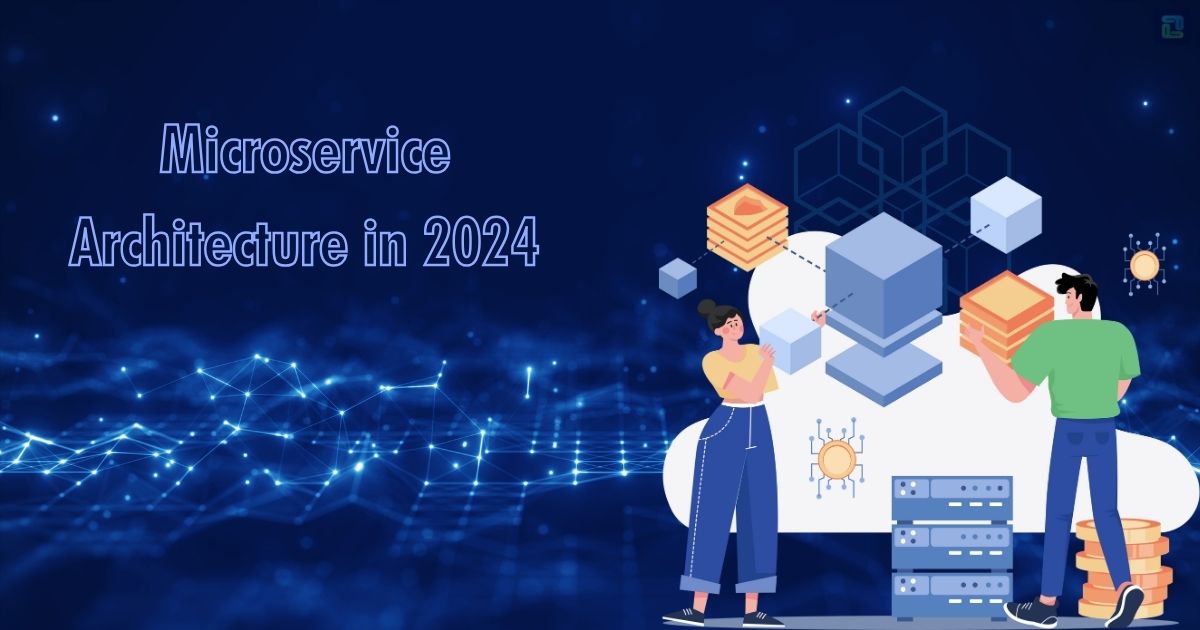All You Need to Know about Microservices Architecture in 2024

All You Need to Know About Microservices Architecture in 2024 In 2024, microservices architecture continues to transform how organizations build, deploy, and maintain software applications. With the growing demand for scalable, flexible, and maintainable applications, microservices have emerged as a go-to solution for many tech companies and enterprises. Understanding microservices, their importance, and when to use them can help organizations optimize their development practices and infrastructure.
This blog will cover everything you need to know about microservices architecture in 2024, including how it differs from monolithic architecture, its key characteristics, why it's important, the microservices-first approach, when to use it, and real-world use cases.
What are Microservices?
Microservices or microservice architecture distinguishes an architectural style that encourages the development of smaller services with narrowly-focused interfaces that can be independently developed, deployed, scaled, and revised.
Microservices are a modern and alternative approach to the classic monolithic architecture which used to involve heavier tooling and more coordination efforts that ultimately added to developer friction.
The single-function modules built as part of microservices come along with clearly defined interfaces and operations. Microservices have grown more popular as enterprises look for more agility and move toward DevOps and a continuous testing framework.
Microservices are the answer to create scalable, testable software solutions that can be continually delivered within short bursts of time, as opposed to apps built with a monolithic architecture which take months/years to complete.
How is Microservices Architecture Different from Monolithic Architecture?
To fully appreciate the impact of microservices, it's crucial to understand how it compares to traditional monolithic architectures.
- Monolithic Architecture:
In a monolithic architecture, an application is built as a single, unified unit. All components of the system (e.g., user interface, business logic, and database management) are tightly coupled and run within a single process. The entire application is deployed and scaled as one large block of code. Common characteristics include:
-
Tight Coupling: All components are interconnected, making it difficult to isolate individual functions or services. -
Unified Codebase: There’s a single codebase where all modules exist together. -
Shared Resources: Components share common memory space and resources. -
Scaling Complexity: Scaling requires replicating the entire application, leading to resource inefficiencies.
- Microservices Architecture:
In contrast, microservices architecture breaks an application into independent services, each of which is self-contained and designed to perform a specific function. These services communicate via APIs, and each can be deployed, maintained, and scaled independently. Key differences include:
-
Loose Coupling: Each service is autonomous and interacts with others only through well-defined APIs. -
Independent Codebases: Each service can have its own repository and be written in different programming languages. -
Decentralized Data Management: Each microservice can manage its own database, leading to more granular control over data access. -
Ease of Scaling: Each service can be scaled independently based on demand.
Characteristics of Microservices
Microservices architecture comes with several key characteristics that make it stand out as a scalable and flexible design pattern in software development:
1. Modularity:Microservices break down an application into smaller, independent modules. Each module or service focuses on a specific business function, such as user authentication, order processing, or payment processing.
2. Independence:Each microservice can be developed, deployed, and scaled independently. This independence allows development teams to work in parallel, reducing time-to-market for new features and improvements.
3. Decentralized Data Management:Unlike monolithic systems where a single database is used, microservices often use decentralized data management. Each service can have its own database, allowing for greater flexibility and performance optimization at the service level.
4. Polyglot Programming:Microservices enable teams to choose different programming languages, frameworks, and technologies for different services. For example, a team could use Node.js for one service and Python for another, depending on the specific requirements and strengths of each language.
5. API-Driven Communication:Services in a microservices architecture communicate via APIs, typically over HTTP, gRPC, or message queues. This API-driven communication ensures that services remain loosely coupled and independent of each other.
6. Resilience:Microservices are designed for resilience. If one service fails, it does not cause the entire application to fail, as microservices are built with fault tolerance and failover mechanisms.
7. Continuous Delivery:Microservices align well with DevOps and continuous delivery practices. Since each service is independent, new features and updates can be pushed to production more frequently and with lower risk of affecting other parts of the system.
Why Microservices are Important
In the fast-paced digital landscape of 2024, businesses need to adapt quickly to changing customer needs, emerging technologies, and market trends. Microservices architecture provides the agility, scalability, and resilience that organizations require to stay competitive.
1. Agility and Speed of Development:Microservices enable teams to develop, test, and deploy new features or services independently, without worrying about impacting the entire application. This approach speeds up development cycles, allows for faster innovation, and reduces time-to-market for new products or features.
2. Scalability:Microservices allow for fine-grained scalability. Rather than scaling an entire monolithic application, businesses can scale individual services based on their needs. For instance, a service handling payment processing can be scaled up independently of the user authentication service.
3. Flexibility in Technology Choices:Since microservices can be developed using different technologies, organizations have the flexibility to choose the right tools for the job. This flexibility fosters innovation and allows teams to use the best programming languages, databases, and frameworks for each service.
4. Resilience and Fault Tolerance:Microservices architecture enhances resilience. If one service fails, it does not cause the entire system to crash. Services can be designed with automatic failover mechanisms, self-healing capabilities, and fallback options to ensure uptime and reliability.
5. Enhanced Collaboration:Microservices promote team autonomy and collaboration. Teams responsible for specific services can work independently, enabling better collaboration across different functions, such as development, testing, and operations.
The Microservices-First Approach
The microservices-first approach is gaining popularity in modern software development, where organizations choose microservices architecture as the foundation of their application from the very beginning, rather than transitioning from a monolithic design later. Here’s why many companies adopt a microservices-first mindset:
1. Start Small and Scale:With a microservices-first approach, companies can start with a few microservices for core functionalities and gradually expand as the application grows. This allows for a more modular, scalable design from day one.
2. Avoid Technical Debt:Building a monolithic application and then transitioning to microservices can lead to technical debt, as existing code must be refactored to fit into the microservices model. Starting with microservices avoids this problem and reduces the complexity of refactoring down the road.
3. Cloud-Native from the Beginning:In 2024, most organizations are leveraging cloud infrastructure. A microservices-first approach aligns well with cloud-native principles, where applications are designed to be stateless, scalable, and fault-tolerant. It allows businesses to take full advantage of the cloud’s elasticity and distributed nature.
4. DevOps and Continuous Delivery Alignment:Microservices architecture aligns well with modern development practices like DevOps and continuous delivery. A microservices-first approach allows for independent deployments, faster release cycles, and more efficient CI/CD pipelines.
When to Use Microservices and Its Known Uses
While microservices offer significant advantages, they are not always the best solution for every project. Here’s when to consider using microservices architecture and some well-known use cases:
- When to Use Microservices:
Large, Complex Applications: If you are building a large application with many distinct features and services, microservices are a good fit as they break down complexity into manageable pieces.Rapidly Growing User Base: If your application is experiencing rapid growth, microservices can help you scale individual services to meet increasing demand without affecting the entire system.Independent Feature Development: If your team needs to develop and release features independently, without waiting for other teams or services, microservices enable parallel development.Cloud-Native or Distributed Applications: If your application is built for the cloud, microservices help leverage the cloud’s elasticity and scalability.
- Known Use Cases of Microservices:
Netflix: Netflix is one of the earliest adopters of microservices. Its platform consists of hundreds of microservices that handle different functionalities, such as user authentication, content delivery, and recommendation algorithms.Amazon: Amazon transitioned from a monolithic architecture to microservices to handle the scale and complexity of its massive e-commerce platform. Each service, from product catalog management to payment processing, is built and deployed independently.Uber: Uber uses microservices to manage the complexity of its ride-hailing service. Different services handle different aspects of the platform, such as driver management, payment processing, and location tracking.Spotify: Spotify leverages microservices to deliver a seamless music-streaming experience. Microservices are used for functions like music recommendation, user playlists, and social features.
Conclusion
Microservices architecture has become a key approach in modern software development. Its ability to enhance agility, scalability, and resilience makes it an attractive option for companies in 2024 and beyond. However, it is important to carefully assess the needs of your application before adopting microservices. By understanding the benefits, challenges, and when to use microservices, organizations can make informed decisions that drive innovation and growth.
Whether you're considering adopting microservices or refining your current implementation, the modular and independent nature of this architecture is a powerful tool for building scalable and robust systems in today’s fast-paced digital world.
Our application containerization services can help containerize your application to microservices architecture and get the most value from your information technology investments. Get in touch with our technical experts to help you transition to the cloud or upgrade your legacy application to a modern cloud-based application.
